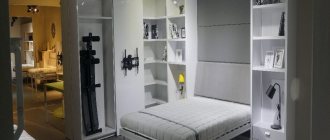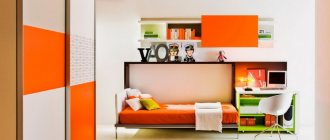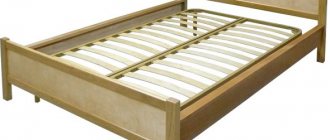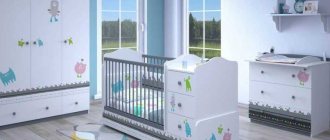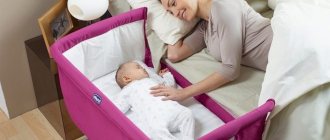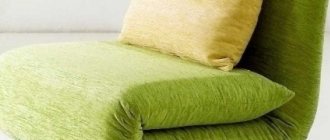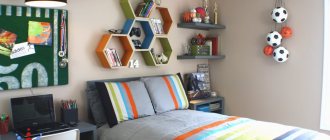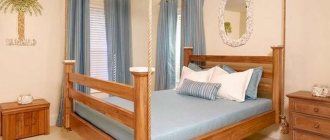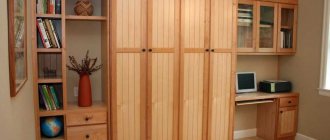Features and benefits of bunk beds
Children sharing a common living space learn how to interact correctly with each other. Find a common language and unifying topics for communication. If such a living space does not have extra square meters, then another reason for combining would be a two-level bed.
A children's room should be cozy, functional and safe at the same time.
Even if there is one child in the family, the two-story design allows you to organize a play space on the first level, and a bed on the second level. The main advantages of this type of bed design are:
- rational distribution of the area of small rooms for children of different ages. The saved space will allow you to organize an additional workplace or area for physical education;
- high strength allows you to withstand loads of up to 90 kg, and in teenage models up to 120 kg;
- additional functionality in the form of retractable storage systems and cabinets where you can put bedding, toys or clothes;
- comfort and convenience. The structure can be installed anywhere in the room.
A two-level children's bed occupies vertical space.
This is a functional area that continues upward, not outward. From the point of view of interior design, models in two tiers, thanks to their attractive design, will allow you to create an atmosphere in the nursery that is conducive to both relaxation and active activities. At children's request, it is possible to decorate each floor in its own unique style and color. The levels of such a structure do not have to be located strictly one below the other. Options are also possible here, for example, below is a teenage bed on the second floor - an attic for a baby.
Thanks to this configuration, even the smallest room can be made more spacious.
Varieties
The manufacturing process for such a bed is not very complicated. Such a two-story bed and ladder can be made of different materials, for example, plywood or chipboard. Also, don’t forget about decor and stylish curtains in the project. If you have already made the decision that you need to make a bunk bed yourself, then you can start doing the work. However, first you need to understand the many existing models of bunk beds, considering the most popular ones.
Classical
It couldn't be easier to do. The design of the product includes two places to sleep, located at different levels from the floor. There is also a side staircase. Typically, this model is placed as furniture in large children's rooms.
With a sofa
Having a sofa section located on the first “floor” is an excellent solution from a functional and aesthetic point of view. This model can be placed in a room of almost any size, and it will be used by household members not only as a bed, but also as a cozy place for leisure and relaxation. It would be quite appropriate to place such a convenient structure in one of the corners of the living room.
With functional details
To make the most ergonomic use of the area of a small room, you can fill the space created under the stairs to accommodate various household items. The size of such a bunk bed is usually much larger than the classic version, but the efficiency is also higher.
Attic
A great design for a small nursery. The second floor is a classic place to sleep, and the first floor is used as a study. It houses a desk, shelving and plans for proper lighting. This model may appeal to adult children who want individual space. It is usually made as a single bed, although if necessary, larger sizes can be provided (taking into account the placement of two people). This bed has a variety of placement options: traditional or in the corner of the room. The main thing is to provide for the strength characteristics of such a product.
Bunk triple bed
To make a traditional model a three-bedroom one, small tricks are used. For example, if there are children in the house and the living space is limited to a small room, it is logical to place a double bed at the bottom. If the bed is made for a child, then the sleeping place is located at the top.
Types of beds
Let's try to understand the variety of models and design features of bunk beds:
- The classic option is two identical beds with one vertically positioned above the other;
- Option for a small children's room - the lower level is folding with the organization of additional space where an adult can be accommodated, a children's bed on the 2nd floor;
- Design with a ladder - the upper tier is shifted relative to the lower one, and drawers are built into the steps of the ladder. There are other models equipped with steps and ladders;
- For the older age group - models without stairs of various modifications with and without level shifts. They are also equipped with built-in storage systems;
- Beds of a perpendicular design for a corner location can be equipped with stairs and additional functionality.
- Transformers are models in which a sofa or sofa is converted into a two-level bed. This option is more suitable for older children.
Types of designs
A bunk bed for children can be designed with drawers for bed linen or toys, a sofa, a wardrobe, or steps made in the form of a chest of drawers. A popular option has become the addition of furniture with a built-in workplace, which is very convenient for schoolchildren.
Among the bed models offered by manufacturers, you can choose an option that will ideally fit into the interior of any style. This could be a princess castle with turrets and pink ponies, a captain's cabin with a helm and rope ladders, or any other fairy-tale option. Of course, you can choose a more neutral solution.
Bunk beds are available for children of different sexes. The theme for their design can be very different - from your favorite cartoon scenes to bright abstract designs. For teenagers, you can also find ideal solutions according to their taste preferences.
Standard with sides
Standard children's furniture with sides for the safety of children is a classic solution that is very popular. These are the models most often used for kindergartens. Depending on the functionality requirements and features of the future application, several of the most common options are offered:
- Bunk bed with cradle. The product is ideal for a family with a newborn. The advantage of this solution is the ability to compactly place furniture, which is important for rooms with small dimensions. At the same time, each of the children will have a sleeping place that fully meets the requirements of his age. Over time, when the cradle loses its relevance, in its place it will be possible to place a free-standing bed of suitable size and design. Thanks to the wide variety of models, you can choose a product for any type of interior.
- Pull-out bed for two children. This is a low design in which the difference in height between the first and second levels does not exceed the thickness of the mattress. A retractable section is used as the lower tier. The bumpers prevent children from falling on each other while sleeping. The height of the upper floor does not exceed the same parameter for a standard bed. This is the optimal solution in a situation where it is impossible to use a classic two-story structure due to the age of the children, their character traits, and lack of confidence in their safety during independent play in the room. Such models fit organically into children's ones, made in the style of minimalism.
- Classic or corner bunk bed. The choice of product depends on the size of the room and the furniture arrangement. Among the advantages of the first option is compactness. The second requires more free space, but from the point of view of psychologists it is optimal. This is due to the fact that one of the children, whose sleeping place is on the first floor, will not experience a feeling of psychological pressure. The models under consideration are suitable for interiors of any style.
For safety reasons, it is not recommended to accommodate children under 4 years old on the top floor. The only exceptions are two-tier pull-out models.
With a cradle Modern bunk beds made of solid wood in the interior of a nursery
Retractable
Classical
Corner
Attic
Bunk children's beds, designed according to the attic principle, are very popular not only in families with two or three children, but also with one child. They make it easy to arrange furniture so that even in a small room you can place everything necessary for the comfortable growth and development of your baby.
The structures represent a kind of “wall”; there is a desk at the bottom, and mounts for sports equipment are provided. The sleeping area is located on the second floor. Depending on the age of the child, you can choose a model that comes with a slide and rope ladder.
For children's rooms of a small area, beds with built-in cabinets, wardrobes, and drawers are offered. The “attic” itself can be designed in the form of a gable roof of a house, a tunnel with soft walls and windows. All structural elements are located at an angle of 90 or 180 degrees relative to each other. Such models are suitable for a wide variety of styles: loft, hi-tech, classic, minimalism.
Matryoshka
This is a bunk pull-out bed, which is a structure with several roll-out sections. In most cases, two sleeping places are provided, but some manufacturers offer options that can comfortably accommodate even three kids. An important advantage of this model is that the furniture takes up a minimum of free space.
By assembling the structure after sleep, you can quickly free up space for games and move freely around the room, even if it is small. It is also important that the child can pull out the section without the help of adults. One of the disadvantages of such furniture is the inability to fit it into a classic interior. If the design uses any of the modern styles, the solution will be successful.
Transformer
Transformers are available in several varieties:
- Sofa beds. They are structures with a folding bed. They are widely in demand due to their presentable appearance and the ability to organize a comfortable area for relaxation during the daytime.
- Retractable models. They are especially popular because of their ease of use (a child can easily pull out the lower module without the help of adults). The disadvantage is the limited choice of design; such models differ only in decorative design.
- Folding designs. In most cases, both beds are built into a closet; when unfolding each of them, a tilt-and-turn mechanism is used. Such solutions are distinguished by their functionality, but not all children are able to cope with the transformation of such a bed on their own.
- Composite models. They are beds in which the legs of the upper berth are installed on the back of the lower floor. Both parts of the structure are securely fixed to each other. Such models are equipped with a removable ladder. Their important feature is the ability to divide the structure into two separate beds.
The functionality of each type of children's transformable bunk beds may differ significantly. Manufacturers offer both models that are simple in design and solutions that are complex in design. This approach allows each buyer to find the optimal option in terms of cost and technical parameters.
Sofa bed
Retractable
Folding Composite
Requirements for children's bunk beds
Since we are talking about children, the first and main requirement for two-story structures will be safety and everything connected with it:
- Stability, strength, reliability. The bed should not wobble or move, all its elements are securely fastened. The structure must be monolithic and unified. Have a margin of safety and withstand constant loads.
- Mandatory presence of limiting handrails or sides at the upper level. They will prevent possible falls and related injuries.
- Possibility to adjust the optimal height of the levels taking into account the growth of the child.
- Structural elements should not contain sharp, protruding corners that increase the risk of injury.
- Fastening elements and connections must be hidden in recesses and protected with plastic plugs.
Which manufacturing material do you prefer?
The most common materials for the production of bunk beds today are wood and metal.
The materials for wooden structures are different types of wood.
Solid wood furniture is considered an ideal option for a children's room. Conifers, beech and oak are used for its production. Wooden models are environmentally friendly, safe, practical to use and have an attractive design.
More expensive furniture with a long service life is assembled from solid wood.
Metal structures are characterized by a lower cost. The bed frame, made of steel alloy, provides special strength. The attractiveness of the product is made by cladding made of wood veneer, MDF panels or laminated chipboard.
The metal base is durable, resistant to damage, and will last your child throughout his childhood.
Types of stairs
One of the main safety criteria when choosing a bunk children's bed is the type of ladder that is included in the package. The future owner has several modifications to choose from:
- The vertical or inclined design is considered the most economical and easiest to manufacture. Structurally, it consists of two side planks, between which there are crossbars used as steps. The vertical staircase is compact, but less comfortable when descending and ascending. Not recommended for children under 6 years of age.
- Beds with a flight of stairs are located at a certain angle in relation to the frame. They are more comfortable and safer for movement due to relatively wide steps, but take up more space. The optimal angle of inclination of the stairs is 70°. It is recommended to choose designs in which the strength of the steps is increased due to aluminum corners. For greater operating safety, models with handrails are available.
- Podium models are structures in the middle of which there is a platform, which simultaneously serves as a step, a work table or a place for games. The best option for school-age children.
- A staircase-cabinet, the steps of which are made up of drawers. For large families, it is especially important to choose functional furniture that uses all the possibilities for convenient storage of things. That is why bunk beds for three children are most often equipped with stairs, which have a drawer under each step. This design can hardly be called compact, but given its spaciousness, the space involved is used really effectively. At the same time, the wardrobe ladder is considered one of the safest for use by children under 4–5 years old.
- Beds with mobile ladders are suitable for teenagers. If necessary, such a structure is attached to the bed; if not needed, it is put away in a niche located under the bed.
From a safety point of view, for children over 4 years old, it is recommended to choose furniture with a ladder-cabinet; vertical or inclined models can be used by children over 6 years old.
Vertical
How to choose a transformable bunk bed for children and adults
Inclined marching type
Podium Staircase-wardrobe
With mobile ladder
What to consider when choosing - basic criteria and rules
When purchasing a two-level bed for a children's room, you should pay attention not only and not so much to the price tag, but also to other important criteria:
- Ask your children for their opinions and be guided by their wishes.
- In order for children to sleep sweetly on a new bed, it must be comfortable and safe. So that children can use it easily and without fear.
- The materials used for production must comply with the norms and requirements of the standards, not contain harmful substances and allergens, not emit a strong odor, and withstand loads.
- The design of the bed base should ensure sufficient ventilation of the mattress and its secure attachment. It is necessary to pay attention to the orthopedic properties of the bed.
- The design and color of the bed should be chosen taking into account the interior of the room into which it should fit organically.
The distance between the sleeping area of the lower tier and the bottom of the bed on the upper tier should be large.
Step-by-step manufacturing guide
And now about how to make a bunk bed for children with your own hands. You need to perform several manipulations to make a bed with two floors.
Follow this sequence:
Cut out all the material based on the data in the drawing. Please note that the size of the frame for the sleeping place should be slightly larger than the size of the mattress. To be more precise, it is 8 cm wide and 10 cm long. In the part of the bed in which the stairs are fastened, you need to add another 4.5 cm. All ribs on the outside need to be chamfered. You can use a hand plow for this. All elements must be sanded and polished. Markings must be made on all structural elements for installation of fasteners. You make the lower and upper frames from the bars that you cut at the initial stage. Fasten it using screws. It is recommended to make at least one partition - it will significantly strengthen the structure. If possible, make 2-3 partitions; they will not be superfluous. You can make a bunk bed from timber with your own hands faster if you prepare all the elements in advance. Using self-tapping screws, you need to screw 20x150 and 20x200 boards to the frame on both sides. They will subsequently perform the function of sides. To make corner support legs, you need to connect 50x100 mm beams along the length at a right angle. The result should be an end in the shape of the Latin letter L. Then you need to make a hole in the support in the place where the upper tier is attached. Similar actions need to be done in a frame with a side of 200 mm. The holes need to be drilled out and made larger so that the top part of the screw, nut and washer can be hidden inside. Use screws to connect the frame and stand
We advise you to study - Socket connection diagram
Please note that making a bunk bed with your own hands takes a little time, especially if you have at least a little experience in this matter. Attach the structure to the wall
If the wall is made of plasterboard, the fastening elements must pass through the profiles. Otherwise the screw will pop out. Mark the places where you need to make fastenings; to do this, lean the bed as tightly as possible. Be sure to use a level to install the frame clearly in the horizontal and vertical planes. Then you need to drill holes through the frame. They must match those in the wall. Screw hex head screws into them. They must be recorded in profiles. If the wall is made of brick, the holes will have to be made with a hammer drill or impact drill. Then you need to insert anchors into these holes. Repeat similar steps with the second frame. Now you need to assemble the fence for the sleeping place located on top. It needs to be screwed to the wall and frame. When assembling a ladder, you need to take two bars and crossbars. The assembled staircase is mounted on supporting frames. The staircase can be of any design - attached or built-in. In the second case, it is necessary to make cutouts for fasteners. Sheets of plywood need to be screwed to the lower and upper frames. You will later lay mattresses on them. The base should be made of wooden slats. Making a bunk bed for children with your own hands is not difficult, but you need to look at the sizes of standard mattresses. It is necessary to secure the beams on the support frame bar, between which the slats are laid. It is recommended to nail them to the plank - this will achieve maximum structural strength. At the last stage, all self-tapping screw heads are covered with a layer of putty, which, after drying, is treated with sandpaper. After this, the entire bed is covered with varnish or paint.
When making a bed from chipboard, it is best to use Euroscrews (confirmants). They hold chipboard sheets much better. But the slats that go under the mattress, as well as the rungs of the stairs, must be made of wood.
Do not install boxes on the top floor - chipboard is heavy and the structure will become much heavier. Such a bunk bed for children (you can make it with your own hands in just a couple of days) will be very convenient - it is heavy and will not fall, even if the child turns the entire room upside down.
Interior layout ideas
Having bought a stylish-looking bunk bed and saved space in the children's room, you have not yet reached the final point. Because now we have to solve the problem of furniture arrangement in the interior.
The iron structure is quite light. The frame is assembled from hollow pipes, so it weighs less than a wooden bed made from chipboard.
To a greater extent, the arrangement will depend on the size of the room and the design features of the bed:
- The traditional location of the bed is by the window, along the wall. This way we get better illumination for reading, drawing or other favorite activities;
- For clear zoning of the room, it is better if the two-story structure faces the wall, and on the opposite side panel you can organize shelves for books and children's small items;
- With a corner location, the interior can be supplemented with a shelving unit or a wall bars for physical education;
- By placing a two-level bed along the window opening, you can create the effect of two separate apartments with a beautiful view from the window.
General assembly principle
Wooden elements used in the structure must be selected in size and have a smooth surface. To fix the transverse strips, side stops (drawbars) are used. During assembly, special glue is applied to them, and after installation, the boards are fixed using clamps. After the adhesive has dried, the clamps are removed and screws are screwed in flush in their place. If desired, the screw head can be masked with furniture plugs or putty
Particular attention is paid to the stability of the device. It must be designed in such a way as to withstand not only the weight of the child, but also his possible pranks or active games
We advise you to study - Drill. types and device. application and operation. how to choose
In addition, if a sleeping place is being prepared for a preschooler, it should be built taking into account the fact that the child will grow.
Special requirements in arranging a bunk bed made of wood are placed on the legs on which the side panels are attached. These elements are best made from hardwood blocks. Additional stops are attached to the parts or grooves are cut out. To give the design an aesthetic appearance, patterns made of thick cardboard are used. It is advisable to make grooves using a jigsaw, which ensures the most accurate cut line. All roughness and cut areas are treated with sandpaper.
After preparing the components, control measurements are taken, after which markings are applied. If all parts correspond to the drawing, assembly can begin. Special dowels are used as connectors. The sockets for their installation are marked with a pencil, then holes of the required diameter are drilled. After fitting, wood glue is applied to the protrusions and final assembly is carried out.
The bunk bed, the drawing of which is given below, is assembled in several stages. The glued base is fixed with clamps. After drying, it finally adheres to the screws. It is worth noting that the correct fit of parts is the key to the success of the construction of the entire structure, so disassembly and assembly can alternate many times during the process. With factory elements it is somewhat simpler, since they are adjusted in advance at the factory.
How to make it yourself
If you have the skills to work with woodworking tools and wood materials, you can try to assemble a two-story bed for a children's bedroom yourself. All work will consist of several stages:
- We choose the design and construction. To do this, you can use existing sketches and drawings, supplementing them with your own thoughts, or develop your own exclusive version.
- We prepare the necessary tools, materials and fasteners. Solid pine or oak is suitable for the frame. Finishing elements can be made from laminated chipboard.
- In accordance with the drawing and assembly diagram, we mark the workpieces, observing the dimensional data. Cut out the details. According to the markings, we drill holes for assembly and fastening.
- First, we assemble the base in the form of a rectangular box, then we make the drawers - the sides of the frame, then we connect all the elements into a single frame. You should start from the bottom tier. Transverse slats are attached to the bases along the entire length for laying the mattress on them.
- The final stage is decoration. Whether your bed will resemble a house or a pirate ship will depend on the flight of your imagination and the chosen interior style.
A bed on a frame made of solid wood with functional and decorative elements made of laminated chipboard combines the best qualities of materials.
If everything is done correctly, then several problems are solved at the same time. Firstly, your children will receive a convenient and comfortable place to relax. Secondly, you will get free space that you can use to your advantage. Thirdly, everyone will be happy.
Decorating a children's room is a creative process. The main thing in it is to take into account the child’s wishes.
Types of bunk beds
Now the furniture industry offers a lot of different models of bunk beds. Based on these designs, it is possible to make your own version, ideally suited to the specific conditions and specifics of the room. The bed will be equipped with a convenient ladder. In addition to traditional solutions, you can also build a loft bed, which is popular today.
If you consider several options, then choosing the right model for a specific children's room will be much more convenient. Therefore, we will consider the most popular models.
Traditional model
This bed for children represents the simplest design of all that exist. Almost anyone with minimal woodworking skills can do it. This model and others like it are good because they have a very small number of components.
Bed with sofa
This model is distinguished by the presence of a folding sofa on the first tier. This saves more room space than a traditional 2-tier design. If there is an ordinary bed on the lower tier, it will not be very comfortable to sit on it - there is no comfortable backrest. Therefore, in addition to the bed in the nursery, you will have to find a place for a sofa or armchairs - this will take up enough space.
Bed with drawers
This is also one of the popular options for modern beds. This model is intended for three children - there are three sleeping places, and the design also includes drawers and shelves. This two-level “monster” will take up a little more space, but it has cabinets and drawers - the child will put toys and his things in them. The design of a bunk bed of this type provides that the drawers will serve as a ladder - this is both compact and ergonomic.
Double bed on the first tier
This bed is not for children, but it can also be successfully used in small apartments. So, the solution is relevant if the apartment is 2-room and one of the rooms is allocated as a living room. On the first floor of this bed there is a sleeping place for two adults, the second is a children's sleeping place.
Bed for a large family
This 2-tier complex is designed for families with four or more children. A children's bunk bed of this level is much more complex and its construction will require significantly more materials, but due to this solution the room will be very spacious, and the sleeping places will be neatly placed along the walls of the room.
Loft bed
You can make your own loft bed. These beds are very popular among space savers. This children's bunk bed is also installed for adult children. This solution is often chosen by adults in one-room apartments. The main difference of this model is that the bed itself is located on the upper tier, and below it is a work area (desk, cabinet, etc.).
On video:
bunk bed models.
